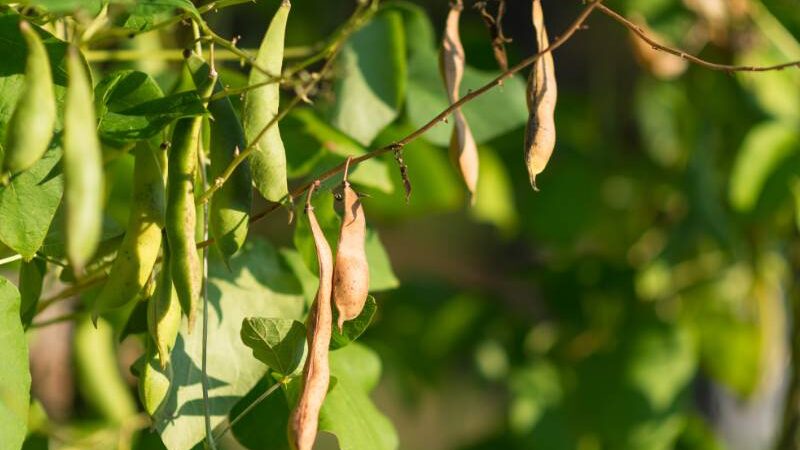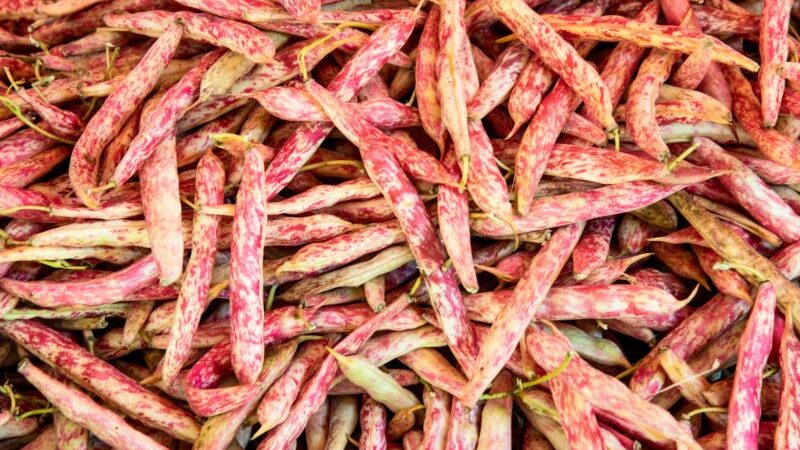Often confused with red beans, kidney beans are a very popular branch of the legume family to grow due to their high content of protein, fiber, and the big amount of dishes it can be served in. Down below, we will see some information on how to grow kidney beans in details.
Before starting, if you already read my article on how to grow red beans, you can skip this one as they are practically grown the same way. If anything, this article on the differences between red beans and kidney beans might be more interesting for you. (coming soon!)

How to Grow Kidney Beans
1- Give the soil a nice touch of compost.
2- Plant the kidney beans 1 inch deep in a 60° Fahrenheit soil in a 70-85° F temperature
3- Space bush beans 3-5 inches apart in rows 2 feet apart and pole beans 10 inches apart in rows 3-4 feet apart. Pole beans planted in double rows should be spaced 10 inches apart and 1 foot in-between rows
4- Water the plants until you have a moist soil but not too much. After taking the weeds (manually) place a nice layer of mulch.
5- The seeds will sprout in 1-2 weeks.
Growing Kidney Beans in Trays or Direct Sowing
If you are wondering whether to grow the beans in seedling trays and then transplanting them, or to direct sow them in the garden, here is a quick comparative.
| Seedling Trays | Direct Sowing | |
| Sowing | Great to sow | Needs to be protected from pest |
| Transplant | Can suffer from transplant shock | Not necessary |
| Time | Can be started earlier | Needs the right weather and soil conditions |
| Light | Need grown lights to grow | Requires a spot with full sun |
Sowing: Seedling trays are a great way to sow your seeds, as you have a better control over them as oppose as plating the seeds in the soil, where there’s need to protect the seeds from pest such as rabbits, mice, and other animals that may dig the seed before they sow.
Pro Tip: To avoid getting your seeds dug up by rabbits, rodents, or other animals, place a hardware cloth or chicken wire until your seeds sow
Transplant: The biggest reason why it’s better to sow beans outdoors is because of their shallow root nature and how easy they can suffer from transplant shock after the transplant. If you plant to transplant them either way, make sure to use an inoculant powder to help the roots get stablished after being transplanted.
Time: In theory, starting plants in seedling trays will give you a time advantage as the seedlings can be formed before the right weather conditions strike in the area. This may be beneficial for green pole beans that can be harvested multiple times or if your area has a short period of warm weather.
Despite this, kidney beans and beans which need to dry before being harvested, time shouldn’t be the main reason to sow beans in seedling trays (unless really necessary due to season conditions in your area). Anyways, we will talk more about drying beans in damp weather areas in the Harvesting section of this article.
Light: Even thought seeds can germinate without light, they do need it to grow bug enough to be transplanted. So it’s always a good idea to grow them under grown lights if sown in seedling trays. They can also be placed in a window where they get full sun, but they will grow leggy.
How to Grow Kidney Beans in a Pot

As kidney beans are shallow rooted plants, they are a very good option to plant in containers, as they won’t need too much space to grow.
Despite this, seeds that need to dry (such as kidney beans) are not optimal to grow in pots, as the pods cannot be picked frequently to induce more growth as it can be done with green beans.
This basically means that either 1- You will need to plant kidney beans in many pots to get a good harvest or 2- The amount harvested will not be as good as it would be in the garden. Anyways, here are the instructions on how to plant them in pots.
To sow kidney beans in containers, plant them 1 inch deep into the soil. You can use potting mix for the soil or just blend one for yourself by mixing 1/3 of compost, 1/3 of peat moss or coco coir and 1/3 of perlite or vermiculite. Just try to make sure your soil is in that Ph range of 6-7 that beans thrive for!
The pot should be about 12 inches in diameter and 10 inches deep. Here I’ll leave a link to amazon to acquire 5 gallon pots that work well to plant bush and vining beans.
It’s also important to have some draining holes ready in any pot that you use. As beans do not like getting “wet feet” as this could lead to root rot.
Soil
To plant kidney beans, the soil should be in a temperature of 60° Fahrenheit or above and have a Ph between 6-7. They do good in any soil but are better planted in clay or loamy soils and it’s very important to give the soil a nice touch of compost before planting them.
For the best results, kidney beans should be located in a spot with full sun. If you are planting vining varieties, make sure to give a good use to the shadows produced by the pole beans and place crops that grow well in partial-sun.
Beans are a great crop to grow as their roots will take nitrogen from the air and place them in the soil they are growing, so it’s not necessary to apply fertilizer for them to grow. It would be counterproductive if anything.
If you want them to grow faster though, apply a mid-season touch of compost or kelp extract solution.
Mulching
As with many plants, applying mulch to your beans is very important.
Before applying mulch, make sure remove all the weeds from your garden bed, preferably by hand as the tools could go too deep into the soil and damage the shallow roots of the beans.
Mulching is a great to maintain the weeds away and will help the soil conserve it’s moisture and temperature, which is very useful during hot spells.
Support
When growing pole kidney beans, it’s useful to make a trellis for the vining pole beans to grow.
There are many different ways to trellis kidney beans. A classic one is to plant some bamboo poles in a circle-shape and connect them at the top with a string in a teepee kind of form. If you are starting to plant kidney beans for the first time this is a good, affordable idea.
Make sure to plant the bamboo poles at least 1 feet deep into the soil if you live in a windy area, as both the weight of the plant and the wind could make things complicated if the support is planted too superficially. In the case you start planting beans regularly, it might be a good idea to get an obelisk trellis.
Beans can also be attached to fences or arches, there is also a bean tower plant support.
If you plan to grow kidney beans (or any type of pole bean) in double rows, you can do a trellis in a X type of form, just as shown in the picture below

Pest and Diseases
Click here to see some of the beans common pest and diseases.
Harvesting
Kidney Beans will be ready to harvest in 4 months (between 100-140 days) after they’ve been planted.
As kidney beans are dry beans we want to harvest the plant when the pods are in a light brown color and the seeds rattle a bit.
There are a couple ways to harvest dry beans. The pods can be picked up by hand when they are ready and then opened to release the seeds, or you can throw the pods into a bag and throw it against the floor like your bouncing a deflated basket ball, most of the seeds will get out of the pods which saves a lot of time.
Despite this, in the second method some parts of the pods will be together with the beans so you will need to winnow your beans to “clean them”.

Harvesting Kidney Beans in Damp Conditions
If you live in an area with damp weather, it’s raining very frequently, or the season’s is about to end and there are still some undried beans in your plants, there are a few actions you can take to finish this process.
Hang the plant and let them dry
A typical thing to do is to pull the plant early and hang it in a basement, barn, or any dry environment. Despite this, taking this approach may cause the plant to get moldy.
Another approach you can take is to take the immature pods directly and let them dry near a window ledge. As soon as they get their typical leathery color take the seeds out and finish drying them in a dry spot in your house or in a dehydrator.



